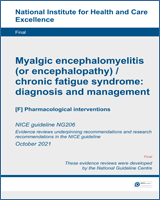From: Pharmacological interventions

NCBI Bookshelf. A service of the National Library of Medicine, National Institutes of Health.
| Outcomes | No of Participants (studies*) Follow up | Quality of the evidence (GRADE) | Relative effect (95% CI) | Anticipated absolute effects | |
|---|---|---|---|---|---|
| Risk with Control | Risk difference with Galantamine hydrobromide versus placebo (95% CI) | ||||
|
Fatigue: fatigue on VAS Scale from: 0 to 10. |
49 (1 study) 2 weeks |
⊕⊝⊝⊝ due to risk of bias, indirectness, imprecision |
The mean fatigue: fatigue on vas at 2 weeks in the control groups was 7.11 |
The mean fatigue: fatigue on vas at 2 weeks in the intervention groups was 0.14 higher (0.84 lower to 1.12 higher) | |
|
Cognitive function: memory on VAS Scale from: 0 to 10. |
49 (1 study) 2 weeks |
⊕⊝⊝⊝ due to risk of bias, indirectness, imprecision |
The mean cognitive function: memory on vas at 2 weeks in the control groups was 4.72 |
The mean cognitive function: memory on vas at 2 weeks in the intervention groups was 0.91 higher (0.67 lower to 2.49 higher) | |
|
Pain: myalgia on VAS Scale from: 0 to 10. |
49 (1 study) 2 weeks |
⊕⊝⊝⊝ due to risk of bias, indirectness, imprecision |
The mean pain: myalgia on vas at 2 weeks in the control groups was 7.99 |
The mean pain: myalgia on vas at 2 weeks in the intervention groups was 0.47 lower (1.39 lower to 0.45 higher) | |
|
Sleep quality: sleep disturbance on VAS Scale from: 0 to 10. |
49 (1 study) 2 weeks |
⊕⊝⊝⊝ due to risk of bias, indirectness, imprecision |
The mean sleep quality: sleep disturbance on vas at 2 weeks in the control groups was 6.66 |
The mean sleep quality: sleep disturbance on vas at 2 weeks in the intervention groups was 0.34 higher (1.02 lower to 1.7 higher) | |
|
Adverse events: AEs dizziness on VAS Scale from: 0 to 10. |
49 (1 study) 2 weeks |
⊕⊝⊝⊝ due to risk of bias, indirectness, imprecision |
The mean adverse events: aes dizziness on vas at 2 weeks in the control groups was 3.54 |
The mean adverse events: aes dizziness on vas at 2 weeks in the intervention groups was 0.72 higher (0.93 lower to 2.37 higher) | |
|
Return to school/work: work capacity/satisfaction on VAS Scale from: 0 to 10. |
39 (1 study) 2 weeks |
⊕⊝⊝⊝ due to risk of bias, indirectness, imprecision |
The mean quality of life: work capacity/satisfaction on vas at 2 weeks in the control groups was 5.09 |
The mean quality of life: work capacity/satisfaction on vas at 2 weeks in the intervention groups was 0.17 lower (1.38 lower to 1.04 higher) | |
| Symptom scales: clinical global impression score, no change or worse |
347 (1 study) 20 weeks |
⊕⊝⊝⊝ due to risk of bias, indirectness, imprecision | RR 0.86 (0.72 to 1.03) | 701 per 1000 |
98 fewer per 1000 (from 196 fewer to 21 more) |
Downgraded by 1 increment if the majority of the evidence was at high risk of bias, and downgraded by 2 increments if the majority of the evidence was at very high risk of bias
The majority of the evidence included an indirect population (downgraded by one increment): downgraded if the ME/CFS diagnostic criteria used did not include PEM as a compulsory feature [original analysis]; percentage of participants with PEM unclear [PEM reanalysis – see Appendix G for additional details]
Downgraded by 1 increment if the confidence interval crossed one MID or by 2 increments if the confidence interval crossed both MIDs
Studies included: Blacker 2004, Snorrason 1996
From: Pharmacological interventions

NCBI Bookshelf. A service of the National Library of Medicine, National Institutes of Health.